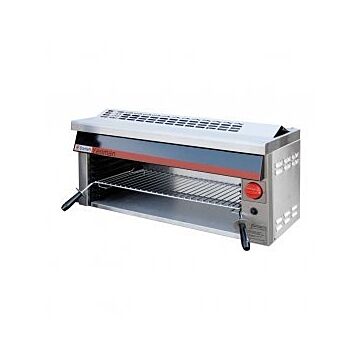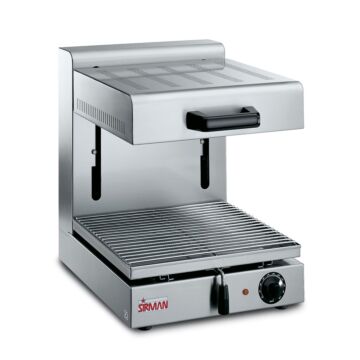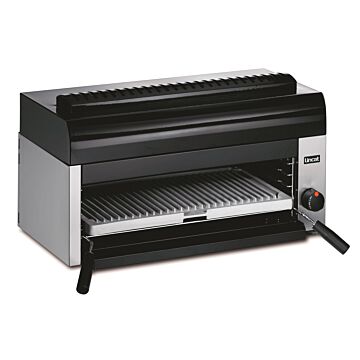For Christmas opening times click here for more details.
Shop 2 stores as 1 | Shared Search, Account & Cart
Checkout using your account
Checkout as a new customer
Creating an account has many benefits:
- See order and shipping status
- Track order history
- Check out faster
Salamander Grills
Salamander grills are one of the units which any professional kitchen would regard as a key piece. We only supply commercial grills & griddles that come with quality as an integral feature and so the products in our range are manufactured by some of the best in the business to guarantee just that.

- Gas kW 5kW
- SKU F-25G
- Delivery Standard 3 to 5 Working Days
- Brand Bartlett
- Height (mm) 390.000000 Show More
Minimum order value £1000 ex VAT

- Power Supply Standard 3 Pin Plug
- Cooking Area 385 x 350
- Warranty Cover 12 Months Parts & Labour
- Colour Stainless Steel
- Kilowatts 1.7 Show More
Minimum order value £1000 ex VAT

- Cooking Area 580 x 275
- Warranty Cover 24 Months Parts & Labour
- SKU GR7
- Delivery Standard 3 to 5 Working Days
- Brand Lincat Catering Equipment Show More
Minimum order value £1000 ex VAT
Commonly Asked Questions About Commercial Salamander Grills
What is a salamander grill used for?
A salamander grill is an invaluable tool for cooking dishes in a commercial kitchen. It is adept at melting cheese, caramelising sugars, browning toppings, grilling a range of foods, and toasting various breads and sandwiches as an alternative to contact grills and panini grills. Beyond its finishing capabilities, it's also effective for maintaining dishes at warm temperatures or even cooking them through when necessary, ensuring its status as a multifunctional asset in any professional culinary setting.
How does a salamander grill work?
Most salamander grills operate using an overhead radiant heat source, usually located at the top of the unit, which can be powered by gas or electricity. Unlike a traditional griddles or chargrills, the elements or burners emit intense heat focused downward to envelop the food, ensuring even cooking without direct contact. The heating method from above not only allows for precise cooking but also minimises the risk of flare-ups, as there's no direct exposure of the heat source to dripping fats. This makes a salamander oven ideal for a restaurant, providing a safe and efficient way to broil/grill, brown, and finish dishes to a professional standard.
What are the advantages of salamander grill?
A salamander grill is an essential, multifunctional appliance for any commercial kitchen, offering high grilling temperatures that exceed 530° C, perfect for searing and grilling. They are designed for fast heating up, eliminating long waits, and their open design ensures easy access for quick loading and unloading. Space efficient salamander grills can be wall-mounted to conserve counter space, and their convenient positioning at eye level near cook lines allows for effortless monitoring of dishes. The intense heat of a cooking salamander along with its user friendly features make it an advantageous tool for busy chefs.
Where should you position a salamander grill?
In a professional foodservice setting, the correct placement of salamander cooking equipment is crucial for efficiency and ease of use. A salamander grill can be countertop or wall mounted, depending on space availability and kitchen layout. Some commercial range ovens are designed with integrated salamanders for convenience. Salamanders are typically installed on a shelf at eye level to facilitate quick and effortless monitoring of the cooking process. Strategic positioning is standard practice for commercial kitchen salamander setups, ensuring optimal functionality and accessibility for chefs during busy service periods.
Should I get a static or height adjustable salamander grill?
Choosing between static or height adjustable for your commercial salamander grill needs depends on the specific requirements of your kitchen and cooking style. A static salamander grill has a fixed heat source, with the pan shelf's being manually adjustable to change the distance between the food and the element or burner. On the other hand, a height adjustable or rise and fall salamander grill allows you to move the entire top grill section, providing faster access and more precise cooking control. The latter is generally more versatile and can accommodate a wider range of cooking techniques. Ultimately, the decision hinges on your intended use, cooking style, and commercial preferences.
Should I choose an electric or gas salamander grill?
Choosing the right salamander grill for your business depends on your specific needs. LPG and natural gas salamander grills are perfect for larger kitchens with high output, offering fast heat-up times and precise temperature control. On the other hand, electric salamander grills are more energy-efficient and better suited for smaller kitchens with lower to medium demand. Both types support salamander techniques and uses excellently, but it's important to consider your operation's size and energy efficiency needs when deciding. With large and small salamander grills available with a choice of power options, selecting the best salamander grill for your catering business is easy.
Are infrared salamander grills good for cooking?
Infrared salamander grills are ideal for cooking, especially in a restaurant where salamander cooking is a common technique. They use infrared heat, which is more direct and intense, allowing for rapid cooking results in fast paced kitchens. Quartz infrared elements are considered more energy efficient, achieving desired conditions faster than other models. Infrared grills provide a high-heat searing capability perfect for quickly cooking steaks to perfection with a delicious crust. The alternative heating method is radiant salamander grills. Radiant grills distribute heat evenly for consistent results, although generally have higher BTUs. The choice between infrared and radiant will depend on the chef's specific cooking needs and preferences in a salamander oven for restaurant use.
Do salamander grills heat food from the top and bottom?
Salamander grills heat food from above, particularly in a commercial salamander oven setting. Gas salamanders use an overhead heat source that radiates down onto the food. While many electric salamander grills also utilise only an upper heat source, models with dual elements, positioned both above and below the food, are also available to provide faster grilling times and more even temperature distribution. These features make them an excellent choice when buying a salamander oven for a restaurant, ensuring quick, consistent results for a variety of dishes every time.
Why is it called a salamander?
The name "salamander" for the specialised grill used in commercial catering settings has a fascinating origin. It is derived from the mythical creature known as the salamander, which, according to ancient Greek mythology, could live in and withstand extreme heat. The association makes perfect sense given the equipment's ability to produce and endure extremely high temperatures, making it an essential tool in a commercial kitchen salamander setup. The term reflects the equipment's robustness and efficiency, much like the legendary resilience of the salamander to hot flames.
